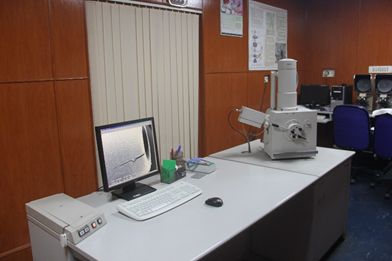
Scanning Electron Microscope

Full Name of the Instrument/Facility :
Scanning Electron Microscope
Make :
Philips Electron Optics B.V. Eindhovan, The Netherlands Scanning Electron Microscope (SEM)
Model :
XL 30 series Scanning Electron Microscope, Serial Number D 1217
Specification :
The XL30 is the conventional Scanning Electron Microscope of the XL Series from Philips and is suitable for a wide variety of applications. The XL30 is a conventional SEM with optimum performance for both imaging and microanalysis of conductive and/or coated specimens. This makes the system ideal for dedicated research in metallography as well as for routine operations such as control monitoring of a manufacturing process, with versatile yet easy to operate software control, the instrument is an excellent tool for both the experienced and first-time user
Resolution: 3.5 nm at 30 kV, 25 nm at 1 kV
Magnification: 20 X to 1000000 X
Resolution: 3.5 nm at 30 kV, 25 nm at 1 kV
Magnification: 20 X to 1000000 X
Working Principles :
- A very fine beam of electrons obtained from electron gun falls on the specimen which scanned over the entire specimen by scanning coils
- Low energy secondary electrons are emitted at the point of impact from the surface of the specimen are then collected by a scintillator ,which converts each electron striking it into a tiny flash of light which generate a small current in the photomultiplier tube.
- The latter part of instrument is a television tube.
- The signal from the detector is fed to the electronic circuit which controls the display of cathode ray tube also.
- The CRT screen is scanned in synchronization with the scanning of the specimen by electron beam.
- The picture appears on the CRT so that the resulting image is an exact representation of the surface of the specimen as imaged by the output of its secondary electrons.
Applications :
- Nanomaterial’s
- Metals, Glass, Ceramics and Polymers
- Semiconductors
- Plastics
- Fibers (Textile, Glass, Asbestos, Natural) Surface morphology & Cross section
- Powder & dust
- Pharmaceutical powder, pellets (Surface & cross section), Capsules
- Biological science,
- Food industry, Chemical industry etc.
User Instructions :
- Sample should be dry and free from moisture
- If it is wet sample then fixation and dehydration of sample should be done by using Osmium tetroxide and glutaraldehyde.
- Back to previous page
- |
-
Page last updated date:22-04-2024 03:25 PM












